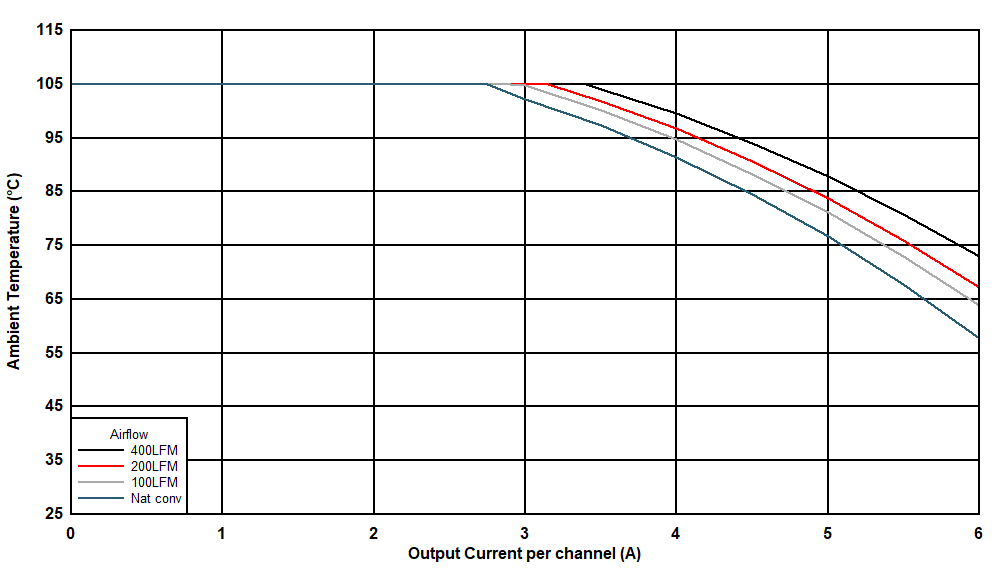SLUAAC9 March 2021 TPSM5D1806
6 Thermal Performance
In addition to the timing and current limits, thermal performance is another key factor to consider for safe module operation. A buck power module integrates the main power dissipating elements in a switch mode power supply – the power switches and magnetics – all into one package.
TI power module datasheets provide Safe Operating Area (SOA) curves such as shown in Figure 6-1. These curves show the maximum allowed ambient temperature versus load current, as an aid to quantifying the thermal capabilities of a given device. Module SOA measurements are typically performed on the module EVM. For the TPSM5D1806, it is important to note that the SOA curves are exercising the module with both channels enabled and set to the same output voltage, and both channels loaded (for example, IOUT1 = IOUT2). This means that the SOA curves can also be used to gauge the thermal performance in dual-phase operation where both TPSM5D1806 channels are tied together to deliver up to 12 A of output current. The x-axis of Figure 6-1 can simply be doubled to get the effective SOA chart for the equivalent dual-phase condition.
One might assume that the bigger the module, the more output power and current it can deliver due to thermal limitations. That may not always be the case, and it is worthwhile to look at different modules' SOA curves to compare their current derating versus ambient temperature. For example, Figure 6-1 indicates that the TPSM5D1806 in dual-phase configuration can deliver up to 8-A (4-A per channel) with VIN = 12 V and VOUT = 1.8 V at ambient temperatures of up to 90°C with no airflow. Meanwhile, Figure 6-2 indicates that the larger single-output TPSM84824 can deliver 8-A at only up to 85°C for the same condition. The TPSM5D1806 comes in a 5.5 x 8 x 1.8 mm (79.2 mm3) QFN package, which is smaller than the TPSM84824 which comes in a 7.5 x 7.5 x 5.3 mm (298 mm3) open frame QFN package.
A caveat to this comparison is that the TPSM84824 SOA measurements were taken on a 4-layer board whereas the TPSM5D1806 SOA was taken on the 6-layer TPSM5D1806EVM. Thermal performance depends on the PCB layout, so the data sheet SOA curves should not be interpreted to represent the module’s thermal capability in any and every layout; it is only meant as a guideline of what performance is possible with a layout and stackup similar to the EVM. Estimating that the TPSM84824 dissipates ~1.9W at this condition and would run ~2°C/W cooler on a 6-layer board versus a 4-layer board (6), the estimated max ambient temperature allowed for the TPSM84824 can be adjusted to approximately 89°C. Even after this adjustment, the smaller TPSM5D1806 offers comparable output capability despite its smaller package.

| FSW = 1.5 MHz, | Dual 1.8-V Outputs, | IOUT1 = IOUT2 |

| FSW = 600 kHz, | VOUT = 1.8 V |